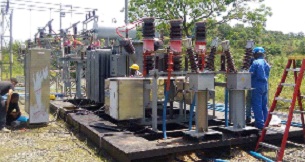A project undertaken by Prefos at Ejisu
THE NORTHERN Sector General Manager of Prefos Ghana limited, Frank Asamoah Agyemang, has declared the company’s commitment to partner the government in expanding rural electrification programmes to all corners of the country.
The government set a target of expanding electricity access rate to a minimum of 90 per cent of the population by the end of 2020 as it sought parliamentary approval for a loan of $100 million to connect 526 communities to the national grid.
At the time of the request, six out of the 16 regions had access rates above the national average of 84.98 per cent with Greater Accra Region ranked number one with 96.66 per cent followed by Ashanti Region with 91.57 per cent.
The Savannah Region was ranked at the bottom of the table with an access rate of 54.51 per cent, according to the then Chairman of the Committee on Mines and Energy, Emmanuel Akwasi Gyamfi.
The Prefos General Manager said the company intended to sit with the government to draw up a plan for the intensification of the rural electrification project, pointing out that Prefos believed that electricity had become a necessity and that every community needed to have access to power especially in this era where most activities were powered by electricity.
Mr. Agyemang told journalists on the sideline of the company’s annual prayer, fasting and thanksgiving programme in Kumasi that Prefos would make available its expertise for this project.
The annual prayer and thanksgiving programme aimed at spiritually fortifying officials and staff of the company prior to the official opening of business for the year.
This year’s event saw several pastors from various denominations taking part in the spiritual exercise which was used to worship and praise God for His goodness to the company for the past 30 years.
He said the company had relentlessly focused on its mission despite the outbreak of the pandemic.
He called on the government to help subsidize the importation of materials to feed the company’s assembling plant.
By Ernest Kofi Adu


